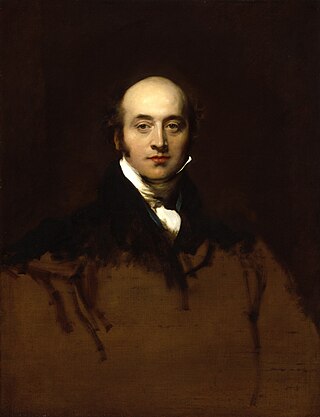
Sir Thomas Lawrence was an English portrait painter and the fourth president of the Royal Academy. A child prodigy, he was born in Bristol and began drawing in Devizes, where his father was an innkeeper at the Bear Hotel in the Market Square. At age ten, having moved to Bath, he was supporting his family with his pastel portraits. At 18, he went to London and soon established his reputation as a portrait painter in oils, receiving his first royal commission, a portrait of Queen Charlotte, in 1790. He stayed at the top of his profession until his death, aged 60, in 1830.

Adriaen Isenbrandt or Adriaen Ysenbrandt was a painter in Bruges, in the final years of Early Netherlandish painting, and the first of the Dutch and Flemish Renaissance painting of the Northern Renaissance. Documentary evidence suggests he was a significant and successful artist of his period, even though no specific works by his hand are clearly documented. Art historians have conjectured that he operated a large workshop specializing in religious subjects and devotional paintings, which were executed in a conservative style in the tradition of the Early Netherlandish painting of the previous century. By his time, the new booming economy of Antwerp had made this the centre of painting in the Low Countries, but the previous centre of Bruges retained considerable prestige.

Juan de Flandes was a Flemish painter active in Spain from 1496 to 1519. His actual name is unknown, although an inscription Juan Astrat on the back of one work suggests a name such as "Jan van der Straat". Jan Sallaert, who became a master in Ghent in 1480, has also been suggested. He worked in the Early Netherlandish style.

The Master of Saint Giles was a Franco-Flemish painter active, probably in Paris, about 1500, working in a delicate Late Gothic manner, with rendering of textures and light and faithful depictions of actual interiors that show his affinities with Netherlandish painting. It is not clear whether the Master of Saint Giles was a French painter who trained in the Low Countries, or a Netherlander who emigrated to France.

Joos van Cleve was a leading painter active in Antwerp from his arrival there around 1511 until his death in 1540 or 1541. Within Dutch and Flemish Renaissance painting, he combines the traditional techniques of Early Netherlandish painting with influences of more contemporary Renaissance painting styles.
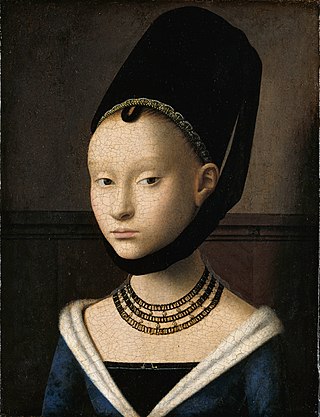
Portrait of a Young Girl is a small oil-on-oak panel painting by the Early Netherlandish painter Petrus Christus. It was completed towards the end of his life, between 1465 and 1470, and is held in the Gemäldegalerie, Berlin. It marks a major stylistic advance in contemporary portraiture; the girl is set in an airy, three-dimensional, realistic setting, and stares out at the viewer with a complicated expression that is reserved, yet intelligent and alert.
Events from the year 1551 in art.
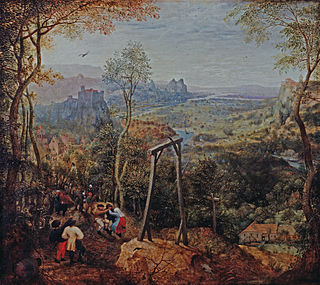
The Magpie on the Gallows is a 1568 oil-on-wood panel painting by the Netherlandish Renaissance artist Pieter Bruegel the Elder. It is now in the Hessisches Landesmuseum in Darmstadt.
The Annunciation is an oil painting by the Early Netherlandish master Jan van Eyck, from around 1434–1436. The panel is housed in the National Gallery of Art in Washington, D.C. It was originally on panel but has been transferred to canvas. It is thought that it was the left (inner) wing of a triptych; there has been no sighting of the other wings since before 1817. The Annunciation is a highly complex work whose iconography is still debated by art historians. It was bought by the Tsar of Russia for the Hermitage Museum, but was sold by Stalin's government in 1930.

Michael Sittow, also known as Master Michiel, Michel Sittow, Michiel, Miguel, and several other variants, was a painter from Tallinn (Reval), Estonia who was trained in the tradition of Early Netherlandish painting. For most of his life, Sittow worked as a court portrait painter, for Isabella of Castile and her Habsburg relatives in Spain and the Netherlands, and other prominent royal houses. He is considered one of the most important Netherlandish painters of the era.

A donor portrait or votive portrait is a portrait in a larger painting or other work showing the person who commissioned and paid for the image, or a member of his, or her, family. Donor portrait usually refers to the portrait or portraits of donors alone, as a section of a larger work, whereas votive portrait may often refer to a whole work of art intended as an ex-voto, including for example a Madonna, especially if the donor is very prominent. The terms are not used very consistently by art historians, as Angela Marisol Roberts points out, and may also be used for smaller religious subjects that were probably made to be retained by the commissioner rather than donated to a church.

Portrait of a Lady is a small oil-on-oak panel painting executed around 1460 by the Netherlandish painter Rogier van der Weyden. The composition is built from the geometric shapes that form the lines of the woman's veil, neckline, face, and arms, and by the fall of the light that illuminates her face and headdress. The vivid contrasts of darkness and light enhance the almost unnatural beauty and Gothic elegance of the model.
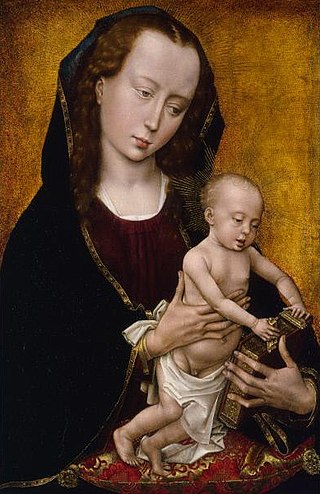
The Diptych of Philip de Croÿ with The Virgin and Child consists of a pair of small oil-on-oak panels painted c. 1460 by the Netherlandish artist Rogier van der Weyden. While the authorship and dating of both works are not in doubt, it is believed but not proven that they were created as wings of a devotional diptych and that at some unknown time the panels were broken apart. A diptych panel fitting the description of the Mary wing was described in a 1629 inventory of paintings owned by Alexandre d'Arenberg, a descendant of Philip I de Croÿ (1435–1511). Both have been approximately dated to 1460 and are now in Antwerp and San Marino, CA respectively. The reverse of de Croÿ's portrait is inscribed with the family crest and the title used by the sitter from 1454 to 1461.

Portrait of Francesco d'Este is a small oil on wood panel painting by the Netherlandish painter Rogier van der Weyden dating to around 1460. The work is in good condition and has been in the Metropolitan Museum of Art, New York since 1931. When attributed as a van der Weyden in the early 20th century, there was much speculation amongst art historians as to the sitter's identity. He was identified as a member of the d'Este family from the crest on the reverse, and long thought to be Francesco's father Lionello, an Italian and highly placed Burgundian prince and patron of Rogier. In 1939 Ernst Kantorowicz identified the man as Lionello's illegitimate son Francesco, which is now generally accepted. The panel was painted when the sitter was about 30 years old and is considered one of van der Weyden's finest portraits, in many ways a culmination of his later, more austere work.

The Magdalen Reading is one of three surviving fragments of a large mid-15th-century oil-on-panel altarpiece by the Early Netherlandish painter Rogier van der Weyden. The panel, originally oak, was completed some time between 1435 and 1438 and has been in the National Gallery, London since 1860. It shows a woman with the pale skin, high cheek bones and oval eyelids typical of the idealised portraits of noble women of the period. She is identifiable as the Magdalen from the jar of ointment placed in the foreground, which is her traditional attribute in Christian art. She is presented as completely absorbed in her reading, a model of the contemplative life, repentant and absolved of past sins. In Catholic tradition the Magdalen was conflated with both Mary of Bethany who anointed the feet of Jesus with oil and the unnamed "sinner" of Luke 7:36–50. Iconography of the Magdalen commonly shows her with a book, in a moment of reflection, in tears, or with eyes averted.

Don Diego de Guevara was a Spanish courtier and ambassador who served four, possibly five, successive Dukes of Burgundy, spanning the Valois and Habsburg dynasties, mostly in the Low Countries. He was also a significant art collector.

The Master of the Prado Adoration of the Magi was a Netherlandish painter active between c. 1475 and 1500 whose identity is now lost. He is thought to have originated from the southern Netherlands and is known for his vibrant colourisation in panels depicting scenes from the infancy of Christ, he is thought to have been a pupil of Rogier van der Weyden, and is named after a copy of the "Adoration of the Magi" panel from that painter's St Columba Altarpiece. Although the Magi became a popular topic for northern painters in the second half of the 15th century and the Columba altarpiece was widely copied, the master is associated with van der Weyden's workshop because the copy is so close, it is believed he must have had access to a reproduction of the underdrawing.

Les Joueurs de football, also referred to as Football Players, is a 1912–13 painting by the French artist, theorist and writer Albert Gleizes. The work was exhibited at the Salon des Indépendants, Paris, March–May 1913. September through December 1913 the painting was exhibited at Erster Deutscher Herbstsalon, Berlin. The work was featured at Galeries Dalmau in Barcelona, 29 November – 12 December 1916, Gleizes' first one-person show. The work was again exhibited at Galeries Dalmau 16 October – 6 November 1926. Stylistically Gleizes' Football Players exemplifies the principle of mobile perspective laid out in Du "Cubisme", written by himself and French painter Jean Metzinger. Guillaume Apollinaire wrote about Les Joueurs de football in an article titled "Le Salon des indépendants", published in L'Intransigeant, 18 March 1913, and again in "A travers le Salon des indépendants", published in Montjoie!, Numéro Spécial, 18 March 1913.
The Collections of the National Gallery of Art Systematic Catalogue is a project of the National Gallery of Art, Washington, to publish a comprehensive catalogue of the paintings, sculpture, and decorative arts in the gallery's collection.
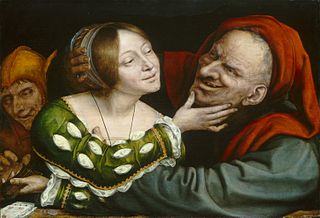
The Ill-Matched Lovers is an oil painting by the early Netherlandish master Quentin Matsys, usually dated between 1520 and 1525. This painting depicts the trope that old age can make one foolish. Matsys depicts this theme by showing an older man besotted by a younger, beautiful woman. He gazes at her adoringly, not noticing that with the aid of an accomplice, she is stealing his purse. The face of the old man was influenced by a drawing done by Leonardo da Vinci, demonstrating Matsys’ skill in combining Northern European themes with Italian elements.
















